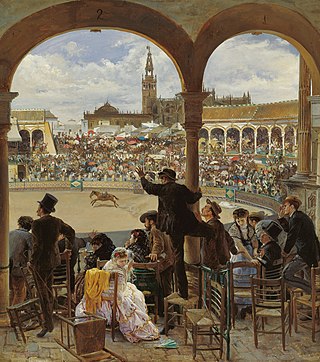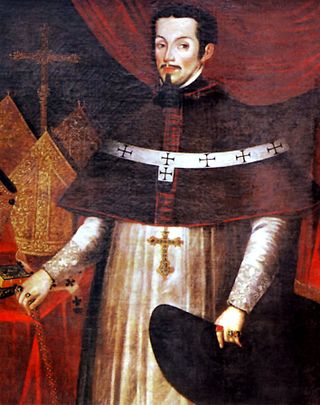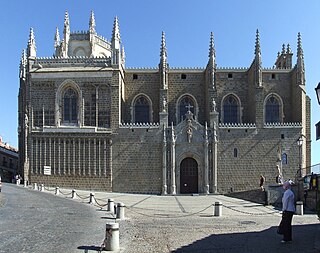Related Research Articles

Pedro Juan Carrasco García was a Spanish boxer whose fame transcended the boxing ring. During the 1970s, he was a media darling in Spain.

Juan Ramón Jiménez Mantecón was a Spanish poet, a prolific writer who received the 1956 Nobel Prize in Literature "for his lyrical poetry, which in the Spanish language constitutes an example of high spirit and artistic purity". One of Jiménez's most important contributions to modern poetry was his advocacy of the concept of "pure poetry".

Admiral-General Luis Carrero Blanco was a Spanish Navy officer and politician. A long-time confidant and right-hand man of dictator Francisco Franco, Carrero served as Spain's Premier and in various other high ranking offices of the Francoist dictatorship until his assassination in a car bombing in December 1973.

Bernal Díaz del Castillo was a Spanish conquistador, who participated as a soldier in the conquest of the Aztec Empire under Hernán Cortés and late in his life wrote an account of the events. As an experienced soldier of fortune, he had already participated in expeditions to Tierra Firme, Cuba, and to Yucatán before joining Cortés. In his later years he was an encomendero and governor in Guatemala where he wrote his memoirs called The True History of the Conquest of New Spain. He began his account of the conquest almost thirty years after the events and later revised and expanded it in response to the biography published by Cortés's chaplain Francisco López de Gómara, which he considered to be largely inaccurate in that it did not give due recognition to the efforts and sacrifices of others in the Spanish expedition.

Fernando Fernández Gómez better known as Fernando Fernán Gómez was a Spanish actor, screenwriter, film director, theater director and member of the Royal Spanish Academy for seven years. He was born in South America while his mother, Spanish actress Carola Fernán-Gómez, was on tour. He would later use her surname for his stage name when he moved to Spain in 1924.

Costumbrismo is the literary or pictorial interpretation of local everyday life, mannerisms, and customs, primarily in the Hispanic scene, and particularly in the 19th century. Costumbrismo is related both to artistic realism and to Romanticism, sharing the Romantic interest in expression as against simple representation and the romantic and realist focus on precise representation of particular times and places, rather than of humanity in the abstract. It is often satiric and even moralizing, but unlike mainstream realism does not usually offer or even imply any particular analysis of the society it depicts. When not satiric, its approach to quaint folkloric detail often has a romanticizing aspect.

Francisco Antonio García Carrasco Díaz was a Spanish soldier and Royal Governor of Chile. His political relations with Juan Martinez de Rozas and a smuggling scandal involving the frigate Scorpion destroyed what little authority he had, and required that he surrender his post to Mateo de Toro Zambrano President of the first govermennt board. He was the last governor to rule before the Chilean independence movement swept the country.

Manuel Quimper Benítez del Pino was a Spanish Peruvian explorer, cartographer, naval officer, and colonial official. He participated in charting the Strait of Juan de Fuca and the Sandwich Islands in the late 18th century. He was later appointed a colonial governor in his native Peru at the beginning of the fight for independence there. He retired to Spain, but was able to return to Peru where he served as a naval officer in the new republic and pursued a literary career, publishing over 20 books about his experiences before his death there in Lima.

Melchor Liñán y Cisneros was a Roman Catholic prelate who served as Archbishop of Lima (1677–1708), Archbishop of La Plata o Charcas (1672–1675), Bishop of Popayán (1667–1672), and Bishop of Santa Marta (1664–1668). He also served as Viceroy of Peru from July 7, 1678, to November 20, 1681.
Juan Ramón Carrasco Torres is a Uruguayan football coach and former player. He is one of the players who had the most appearances, in different rosters, in Uruguay.
Juan Carrasco was a Spanish naval officer, explorer, and navigator. He is remembered mainly for his work in the Pacific Northwest during the late 18th century. He was second in command of the 1791 voyage of José María Narváez, the first European exploration of the Strait of Georgia.

The Monastery of San Juan de los Reyes is an Isabelline style Franciscan monastery in Toledo, in Castile-La Mancha, Spain, built by the Catholic Monarchs (1477–1504).

General Juan Carrasco (1878–1922) was a Mexican rancher and military officer who participated in the Mexican Revolution. He was Chief of Military Operations of Baja California, Sonora, Sinaloa, and Nayarit.

Manuel Carrasco i Formiguera, was a Spanish lawyer and Christian democrat Catalan nationalist politician. His execution, by order of Francisco Franco, provoked protests from Catholic journalists such as Joseph Ageorges, the President of the International Federation of Catholic Journalists. Ageorges wrote, "Even more than the death of the Duke of Enghien stained the memory of Napoleon, the death of Carrasco has stained the reputation of Franco". Such protests, in turn, provoked the anger of the Francoist press. His funeral in Paris on 27 April 1938 was attended by many notable people, including Joan Miró, Ossorio y Gallardo, Josep M. de Sagarra, Joaquim Ventalló and Jacques Maritain and his wife Raissa.

Yannick Ferreira Carrasco is a Belgian professional footballer who plays for Saudi Pro League club Al-Shabab and the Belgium national team. A versatile player, Carrasco can be deployed as a left midfielder, left wing-back or left winger.

Diego Mateo López Zapata was a Spanish physician and philosopher who was denounced by the Spanish Inquisition and subsequently tortured for following and promoting Judaism in the 17th and 18th centuries. Zapata treated a number of influential figures in the court of King Philip V.
Juan Carrasco may refer to:
The LOS40 Music Awards 2019 was the fourteenth edition of the LOS40 Music Awards, the annual awards organized by Spanish radio station Los 40. It was held on November 8, 2019, in the WiZink Center in Madrid, Spain.
Jesús Carrasco, born 1972 in Olivenza, is a Spanish writer. He held a wide range of jobs in his youth, from PE teacher to grape-picker to graphic designer. In 1992, he moved to Madrid where he began his writing career. In 2005, he moved to Seville, where he still lives.
The 113th Mixed Brigade was a unit of the Spanish Republican Army that participated in the Spanish Civil War, deployed on the Tagus front.
References
![]() This article incorporates text from a publication now in the public domain : Singer, Isidore; et al., eds. (1901–1906). "Carrasco, Juan". The Jewish Encyclopedia . New York: Funk & Wagnalls.
This article incorporates text from a publication now in the public domain : Singer, Isidore; et al., eds. (1901–1906). "Carrasco, Juan". The Jewish Encyclopedia . New York: Funk & Wagnalls.